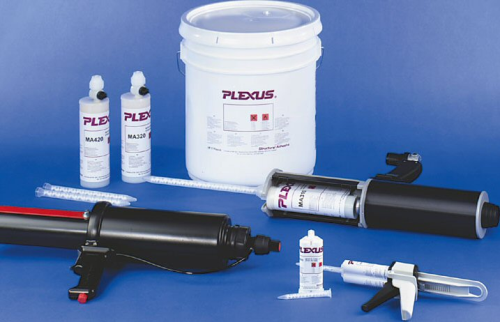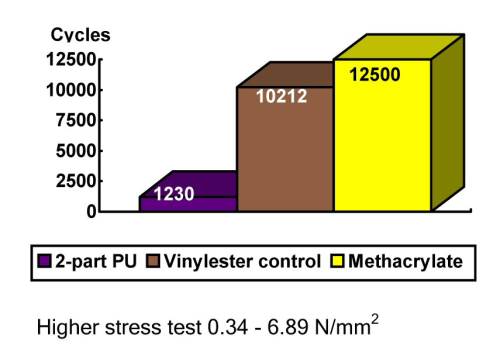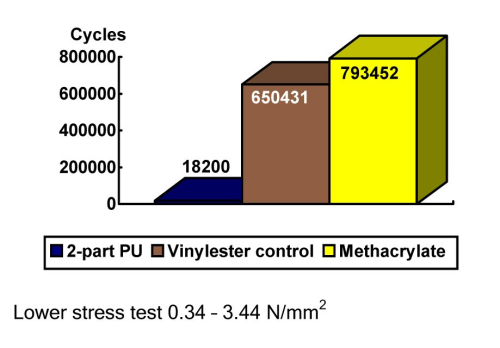



The term ‘structural adhesive’ typically defines an adhesive which can withstand high loads under a variety of different stresses for long periods of time. Structural adhesives are typically high molecular weight molecules, which are required to withstand and distribute the loads within a joint.
The reasons for using adhesive in preference to a mechanical fastening are two fold. Mechanical fastenings can cause stress around the fixing, resulting in stress cracking and where possible failure of the substrate. Adhesives can remove this. The bond line between the two materials produces lower stresses because the load is applied over a larger surface area. Along with this the adhesive provides a layer between the materials that can absorb energy in impact, allow for thermal expansion and act as a layer to resist fatigue.
Methacrylate technology
Plexus adhesives are methacrylate adhesives that have been developed to perform under a wide range of conditions. This is achieved by improving curing, bonding, adhesion and toughening mechanisms.
The free radical cure mechanism of Plexus methacrylates is catalytic in nature. When the adhesive and activators are mixed, amines in the adhesive cause the peroxide to decompose into free radicals, which initiate the process of chain polymerisation of the MMA to PMMA. These reactions are exothermic and take place at room temperature removing the need for applying heat to initiate the cure. The improved adhesion mechanism of methacrylate adhesives consists of the low viscosity monomer solvating the surface of most thermoplastics prior to the curing mechanism beginning. The monomer can solvate most surface contaminants which removes the need for any surface preparation prior to applying the adhesive.
Plexus methacrylate adhesives have a unique combination of polymers and impact modifiers which enable them to be strong yet flexible. The resulting high tensile strength along with impressive elongation (over 100% at @ 30°C) gives them the processing advantages and convenience of epoxies and polyurethanes, without increased cost.
The total combination of all these factors along with good rheology, thixotropic properties, ease of use and lack of VOCs and solvents, results in a range of structural methacrylate adhesives that can be successfully used in the marine, construction and automotive markets on a wide range of substrates.
Adhesive selection
Selecting an adhesive for a bonding application is best done during the design procedure when parameters can be outlined and determined. This makes the adhesive selection process easier. The user must first determine the process constraints and the conditions to which the final bonded assembly will be exposed. Then the substrate and adhesive selection can be made. Involving the adhesive manufacturer at this early stage can omit any later problems associated with wrong selection which can result in delayed production and field failures.
In addition, the main factors which need to be defined for the application before choosing the adhesive are:
- What are the substrates?
- What is the function of the bonded assembly?
- What stresses will the adhesive see (shear, peel etc.)?
- To what environmental/durability conditions will the final bonded assembly be exposed?
- What is the required bond line thickness?
- To what temperatures will the adhesive be subjected?
- What are the plant environments where the adhesive will be used?
- What are the working / fixture times required?
- How will you apply the chosen adhesive?
Once these factors have been determined, testing can be carried out to ensue the correct adhesive is chosen for the application in question.
Applications
Plexus adhesives are used by major domestic and foreign automotive and truck manufacturers. The ability of Plexus adhesives to bond most thermoplastic and composite materials allows manufacturers to simplify assembly and generally reduce the weight of the final bonded assembly.
Transport & automotive
Plexus adhesives are being successfully used in the automotive and truck industry for bonding, for example, bumpers, instrument panels, spoilers, cosmetic surface repairs, airbag housings, glove boxes, door panels, plastics headlights, tail light assemblies, strengthening and structural body parts, grille components, inner door extensions, roof assemblies, side and roof panels and sleeper cabins.
It is not only thermoplastic applications that can benefit from the use of methacrylate adhesives. Composite materials are used in many industries for a variety of different applications. Composite is a general term which means the assembly of dissimilar materials used together to enable them to do a job that the individual materials can not do by themselves. Plexus adhesives have provided an alternative to traditional methods of bonding composites and also allow the bonding of dissimilar materials, e.g. SMC to E-coated steel, fibreglass to aluminium.
Marine
Traditional methods of ‘bonding’ are common place particularly in the marine market, where large quantities of fibreglass products are used. With traditional assembly methods, boat joints are formed by building up layers of fibreglass scrim and resin or by using marine putties. Conditions such as temperature, UV radiation, moisture, impact, chemicals and general wear and tear can weaken joints so dramatically that they fail. This can cause leaks, which can hinder boat performance. Plexus developed 'Fibreglass Fusion' adhesives which when applied dissolve a thin layer of each mating surface and create a chemically cross-linked bond. They actually fuse two fibreglass surfaces into one. The adhesion is so strong that the fibreglass itself will delaminate or break before the bond fails.
Where Plexus has proved particularly revolutionary is in the bonding of deck to hull and stringer bonding. Not only does bonding with methacrylate adhesives save time and reduce labour costs but it also provides a strong, durable, flexible, energy absorbing bond line, which is not susceptible to cracking or brittleness.
Some of the major considerations when choosing an adhesive for this type of application are fatigue resistance, flexibility to absorb the vibrations and withstand the stresses caused by the pounding wind and water, and high speed on performance boats. When compared, for fatigue resistance, to samples bonded with a marine urethane adhesive and parts traditionally glassed together, Plexus adhesives out-performed the urethane and equalled the glassed parts.
Construction industry
The ability of Plexus adhesives to withstand environmental and chemical conditions comes into play not only in the marine and automotive industry but also in the construction industry, where many bonded assemblies are positioned outside or exposed to different chemicals, e.g. acids, bases, diesel, petrol. Plexus adhesives’ durability is down to its adhesion mechanism, which ensures that the bond strength is stronger than either the substrate strength or the cohesive strength of the adhesive. This is particularly important with bonding applications such as external signs or exterior doors. Both these bonded applications are submitted to all types of environmental conditions often prior to use, e.g. paint bake cycles. Plexus adhesives have been proven to perform as good as, sometimes better than control values when exposed to extreme hot/cold cycles, humidity and salt conditions.
Summary
Plexus methacrylate adhesives offer an alternative to many traditional methods of joining two substrates together. They possess the high strength of an epoxy combined with the flexibility of a polyurethane, due to unique combination of polymers and impact modifiers. The free radical chain-polymerisation cure of
| If you would like further information about any of the issues covered in this feature please e-mail us. |
methacrylate adhesives means they cure at room temperature and are not as susceptible to off-ratio mixing. Many thermoplastics, composites and metals can be bonded with Plexus adhesives with little or no surface preparation. The bonding of dissimilar materials can be achieved successfully which means more industries can benefit from using adhesive. The use of an adhesive over other methods can reduce labour costs and increase productivity as well as providing a strong, flexible, tough, durable bond that can withstand fatigue vibration and impact.
The combination of all these factors combined with good rheology, thixotropic properties, ease of use, recyclability, and lack of VOCs and solvents, results in a wide range of structural methacrylate adhesives that can be used to bond many substrates in a variety of different industries.






